Design and construction
Designed by Nathaniel Barnaby, the Royal Navy's Chief Constructor, both ships was ordered from the Govan yard of Robert Napier and Sons in 1873 and laid down the same year as yard numbers 333 and 334. They were launched within days of each other in October 1874. [1]
The hull was built of iron frames and ribs, and planked in wood. [1] This "composite" construction was both cheap and easy to repair and allowed the wooden planking to be coppered, reducing marine growth. On far-flung colonial stations, the benefits of both simple repair and reduced marine growth were particularly positive, due to a lack of substantial ship repair and careening facilities. For this reason, smaller vessels like the Arab class continued to use composite construction until long after larger vessels had transitioned to iron or steel construction.
Propulsion
Steam was provided at 60 pounds per square inch (410 kPa) by 3 boilers to a single 2-cylinder horizontal compound-expansion steam engine generating a designed 570 indicated horsepower (430 kW). In the event, Arab produced 656 ihp on trials, and Lily produced 829 ihp. A single screw was provided, which could be hoisted clear of the water to improve the ship's hull lines when sailing. A sailing rig was provided, with square rig on the fore and main masts, and fore-and-aft rigging only on the mizzen, giving her a "barque" rig. [1]
Armament
A single 7-inch rifled muzzle-loading gun amidships and two 6.3-inch 64-pounder rifled muzzle-loading guns, one forward and one aft, and both fitted on traversing slides, constituted the main armament. Two machine guns and a light gun were also fitted. [1] Arab (but not her sister ship) was re-armed in about 1879, with the after 6.3-inch 64-pounder gun replaced by three 20-pounder breech-loading guns under a newly constructed poop deck. [1]

The Osprey class was a Royal Navy class of screw-driven sloops built between 1874 and 1877. Nine additional ships were built to a revised design, the Doterel-class sloop. They were the first class of ship in the Royal Navy to use glass scuttles.
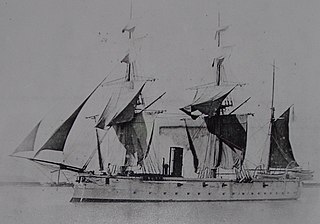
The Amazon class was a class of six screw sloops of wooden construction built for the Royal Navy between 1865 and 1866.

The Fantome class was a six-ship class of 4-gun screw composite sloops built for the Royal Navy during 1873 and 1874.

The Eclipse class was a class of seven 6-gun wooden screw sloops built for the Royal Navy between 1867 and 1870. They were re-armed and re-classified as 12-gun corvettes in 1876. Two further vessels were proposed but never ordered.

The Vigilant-class gunvessel of the Royal Navy was an enlarged version of the Arrow-class gunvessel of 1854. Both classes were designed for shallow-water operations in the Baltic and Black Seas during the Crimean War. Fourteen of the class were completed, but were ready too late to take part in that conflict. Cormorant was sunk in action at the Taku Forts, Osprey was wrecked on the coast of Africa in 1867 and the rest were all sold during the 1860s, with Sparrowhawk lasting until 1872.

The Condor-class gunvessel was a class of four Royal Navy composite gunvessels of 3 guns, built between 1876 and 1877. They were all hulked or sold before 1893, giving them an active life of less than 15 years.

HMS Eclipse was a four-gun Cormorant-class first-class gunvessel launched in 1860 from the shipyard of J. Scott Russell & Co., Millwall. She served on the Australia Station, took part in the Second Taranaki War, including contributing men to a naval brigade which attacked the Maori stronghold at Gate Pā. The entire class were never satisfactory as gunvessels, partly due to their excessive draught, and Eclipse was broken up at Sheerness in 1867, only seven years after her launch.
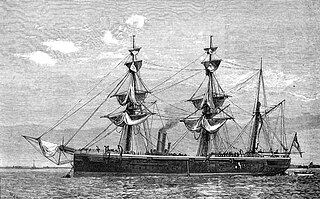
The Doterel class was a Royal Navy class of screw-driven sloops. They were of composite construction, with wooden hulls over an iron frame. They were a revised version of an 1874 design by the Royal Navy's Chief Constructor, William Henry White, the Osprey-class sloop. Two of the class were lost, one to an explosion off Chile and one wrecked off Canada. Gannet is preserved at Chatham Historic Dockyard.

HMS Myrmidon was a Cormorant-class gunvessel of the Royal Navy, built at Chatham Dockyard and launched in 1867. She served on the North America and West Indies Station and surveyed parts of the Australian coast before being sold at Hong Kong in 1889.

HMS Espiegle was a Doterel-class sloop of the Royal Navy, built at the Devonport Dockyard and launched on 3 August 1880.
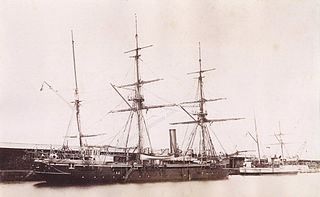
HMS Rambler was an Algerine-class gunvessel of the Royal Navy, built by John Elder & Co., Glasgow and launched on 26 January 1880. She was commissioned as a survey vessel in 1884 and served in Chinese waters during the 1880s and 1890s. She provided men to a naval brigade during the Boer War and was sold on 23 January 1907. The work of this vessel is now remembered in Hong Kong by the Rambler Channel near Tsing Yi.

The Algerine-class gunvessel was a class of three Royal Navy composite gunvessels built in 1880. Two of them were sold after only ten years of service, but the other was converted to a survey ship before commissioning and survived in this role until 1907.
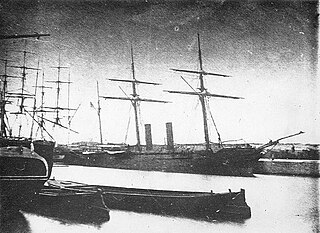
Intrepid-class gunvessels were a class of six Royal Navy first-class wooden gunvessels built in 1855-56. They were rated as sloops from 1859 to 1862, and were scrapped by 1865. Victor was sold to the Confederate States of America as the raider CSS Rappahannock, but she was interned by the French at Calais and never fulfilled her intended function.

HMS Mutine was a Doterel-class sloop of the Royal Navy, built at the Devonport Dockyard and launched on 20 July 1880. She became a boom defence vessel at Southampton in 1899 and was renamed Azov in 1904. She was sold after World War I.

HMS Dragon was a Doterel-class sloop of the Royal Navy, built at Devonport Dockyard and launched on 30 May 1878. She served in the East Indies, including the Anglo-Egyptian War of 1882, and the suppression of slavery. She was sold for breaking in 1892.
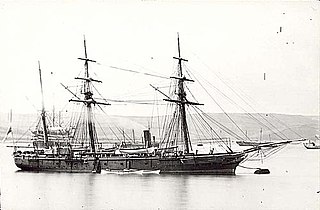
HMS Arab was an Arab-class composite gunvessel built for the Royal Navy in 1874. She served in the East Indies and was sold in 1889.

HMS Lily was an Arab-class composite gunvessel built for the Royal Navy. She was launched in 1874, saw service in Chinese and North American waters, and was wrecked on the coast of Labrador on 16 September 1889.

The Beacon-class gunvessels were a class of composite gunboats built for the Royal Navy in the late 1860s. They were the first warships of the Royal Navy expressly designed to use the engines of an older class of ships with a different hull shape. They were generally deployed overseas to the China, East Indies, West Africa, Pacific, North America and West Indies Stations. In addition to showing the flag, the ships fought pirates and suppressed the slave trade in East and West Africa. As their engines wore out in the mid-1880s, they were mostly retired and scrapped by the end of the decade. A few survived into the early 1900s as they were modified for harbour service before being sold or scrapped.

The Britomart-class gunboat was a class of sixteen gunboats built for the Royal Navy in 1859–1867.

The Cormorant-class gunvessels were a class of 4-gun first-class gunvessels built for the Royal Navy in the 1860s. They were somewhat unsuccessful; intended for shore bombardment in shallow water, they exceeded their design draft by 50%. Seven of the 13 ships ordered were suspended, with 3 finished or converted as survey ships and the other 4 cancelled. Racehorse was wrecked after only 4 years, and those ships that were completed as planned had short operational lives, in some cases less than 10 years. The survey vessels lasted longest, with the last ship of the class, Sylvia, being broken up in 1890.


















